TT pistol
| TT (Tula Tokarev) | |
|---|---|
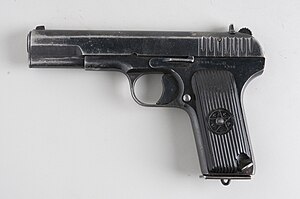 TT-33 | |
| Type | Semi-automatic pistol |
| Place of origin | Soviet Union |
| Service history | |
| In service | 1930–present |
| Used by | SeeUsers |
| Wars | SeeConflicts |
| Production history | |
| Designer | Fedor Tokarev |
| Designed | 1930 |
| Manufacturer | Tula Arms Plant,Izhevsk Arsenal,Norinco,Femaru,FB Radom,Cugir Arsenal,Zastava Arms,FÉG |
| Produced | 1930–1955 (in Soviet Union)[1] |
| No.built | 1,330,000 |
| Variants | TT-30, TT-33, TTC, M48, M48 Tokagypt, M57, M70, M70, R-3, Type 51, Type 54, Type 68, K-14 |
| Specifications | |
| Mass | 854 g (30.1 oz)[2] |
| Length | 195 mm (7.7 in)[2] |
| Barrellength | 116 mm (4.6 in)[2] |
| Height | 134 mm (5.3 in) |
| Cartridge | 7.62×25mm Tokarev 9×19mm Parabellum |
| Action | Short recoil actuated,locked breech, single action |
| Muzzle velocity | 420 m/s (1,378 ft/s)[2] |
| Effective firing range | 50 m |
| Feed system | 8-round detachablebox magazineor 9-round detachablebox magazinecompatible withZastava M57 |
| Sights | Front blade, rear notch 156 mm (6.1 in) sight radius |
TheTT-30,[a]commonly known simply as theTokarev,is a Sovietsemi-automatic pistol.It was developed during the late 1920s byFedor Tokarevas aservice pistolfor theSoviet Armed Forcesand was based on the earlier pistol designs ofJohn Moses Browning,albeit with a number of detail modifications to simplify production and maintenance.[2]The Soviet Union ceased production of the TT in 1954, although derivatives of the pistol continued to be manufactured for many years in thePeople's Republic of Chinaand a number of nations aligned with the Soviet bloc.[2]
Development
[edit]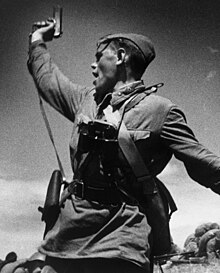
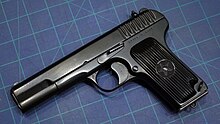
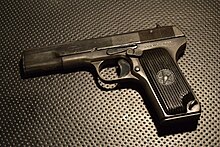
In 1930, theRevolutionary Military Councilapproved a resolution to test new small arms to replace its agingNagant M1895revolvers.[citation needed]During these tests, on 7 January 1931, the potential of a pistol designed by Fedor Tokarev was noted. A few weeks later, 1,000 TT-30s were ordered for troop trials, and the pistol was adopted for service in the (USSR) Red Army.[3]The TT-30 was manufactured between 1930 and 1936, with about 93,000 being produced.
Even as the TT-30 was being put into production, design changes were made to simplify manufacturing. Minor changes to the barrel, disconnector,[4]trigger and frame were implemented, the most notable ones being the omission of the removable hammer assembly and changes to the full-circumference locking lugs. This redesigned pistol was theTT-33.[3]Most TT-33s were issued to commanding officers. The TT-33 was widely used by Soviet troops duringWorld War II,but did not completely replace the Nagant. From 1931 to 1945, a total of 1,330,000 Tokarevs were produced in the Soviet Union.[5]
Design details
[edit]Externally, the TT-33 is very similar toJohn Browning'sblowbackoperatedFN Model 1903 semiautomatic pistol,and internally it uses Browning'sshort recoiltilting-barrel system from theM1911 pistol.In other areas the TT-33 differs more from Browning's designs—it employs a much simpler hammer/searassembly than the M1911. This assembly is removable from the pistol as a modular unit and includes machined magazine feed lips, preventing misfeeds when a damaged magazine is loaded into the magazine well.[6] Soviet engineers made several alterations to make the mechanism easier to produce and maintain, most notably the simplifications of the barrel's locking lugs, allowing fewer machining steps. Some models use a captive recoil spring secured to the guide rod, which depends on the barrel bushing to hold it under tension.
The TT-33 is chambered for the7.62×25mm Tokarevcartridge, which was itself based on the similar7.63×25mm Mausercartridge used in theMauser C96pistol. The 7.62×25mm cartridge is powerful, has an extremely flat trajectory, and is capable of penetrating thick clothing and soft body armor.[7]
Variants
[edit]Due to their reliability, large numbers of TT-33s were produced during World War II and well into the 1950s. The TT-33 was eventually replaced by the 8-round,9×18mm MakarovPMpistol in 1952.
TheWehrmachtcaptured TT-33s and issued them to units under thePistole 615(r)designation. This was made possible by the fact that Russian 7.62 mm Model 1930 Type P cartridges were nearly identical to the German7.63×25mm Mausercartridge, although in German service the9×19mm Parabellumround was more common. Russian cartridges are loaded to much higher pressures, so using them in German Mauser pistols can cause damage, and is advised against.[6]
In 1949, asilencedvariant was produced. Uniquely, the silencer is attached to the barrel bushing rather than the barrel itself. The combined weight of the suppressor with the slide prevents semi-auto cycling of the action, forcing the user to manually cycle it in the same manner aspump actionfirearms. It would later be replaced by thePB pistolin 1967.
InterarmsmarketedWorld War II–surplus Russian-made Tokarevs in Europe and the United States as thePhoenix.They had new wooden grips with a phoenix design on them and were overstamped INTERARMS on the barrel. Later gun laws banned their sale due to their lack of a safety.[citation needed]
In modern times, the robust TT-33 has been converted to many powerful cartridges including.38 Superand9×23mm Winchester.The TT-33 omitted a safety catch other than the half cock notch, which rendered the trigger inoperable until the hammer was pulled back to full cock and then lowered manually to the half cock position. Many variants imported into the US have had manual safeties added, which vary greatly in placement and function.
Foreign production
[edit]Production of the TT-33 in Russia ended in 1954, but copies (licensed or otherwise) were also made by other countries. At one time or another, most communist orSoviet bloccountries created a variation of the TT-33 pistol.
China
[edit]
The TT pistol was copied in China as theType 51,Type 54,M20,andTU-90.[8]
Norinco,thePeople's Liberation Army's state armaments manufacturer in China, manufactured a commercial variant of the Tokarev pistol chambered in the more common 9×19mm Parabellum round, known as theTokarev Model 213,as well as in the original 7.62×25mm caliber.
The 9mm model features a safety catch, which was absent on Russian-produced TT-33 handguns. Furthermore, the Model 213 features the thin slide grip grooves, as opposed to the original Russian wide-types. The 9mm model is featured with a magazine well block mounted in the rear of the magazine well to accept 9mm type magazines without frame modification.
The Norinco model in current production is not available for sale in the United States due to import prohibitions on Chinese firearms, although older handguns of the Model 213 type imported in the 1980s and 1990s are common. Norinco now makes the NP-17, a modernized, two-tone variant on the Model 213.
7.62×25mm ammo is also rather inexpensive and locally produced or imported from China, also made byNorinco.The Type-54 was replaced in the mid to late 1990s by theQSZ-92in PLA service.
Hungary
[edit]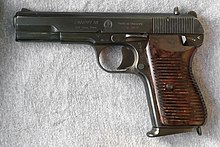
Hungary produced licensed copies of the TT-33 as the Pisztoly 48 Minta commonly referred to as theM48or48M,[9]as well as an export version for Egypt known as theTokagypt 58chambered for the9×19mm Parabellumround which was widely used by police forces there.[6]Tokagypts differ from the M48 by an external thumb safety, an ergonomic wraparound grip, and a magazine with a finger rest.[10]
Egypt, however, cancelled its order after less than half of the 30,000 pistols ordered were delivered.[b]The remaining pistols were sold commercially by FÉG.[11]
North Korea
[edit]North Koreamanufactured them as theType 68orM68.[6]
Pakistan
[edit]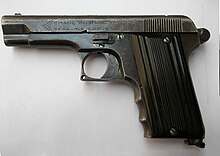
Both legal and illegal TT pistols are still manufactured in various PakistaniKhyber Passfactories.[12]
Poland
[edit]
Poland produced their own copies as thePistolet wzór 1933 (P-33),[13]manufactured from 1947 to 1959.[6] In mid-50s a training version of P-33 was created, chambered in.22lr calledTT Sportowy.All of those pistols were converted between 1954 and 1958 from the 7.62mm variant by changing the barrel and removing the locking lugs from slide.
Additionally, the Radom M48 was created in Radom, Poland as another slightly modified copy of the TT-33.
Romania
[edit]Romania produced a TT-33 copy as theTTC,orTokarev Cugirwell into the 1950s. These have been made available for commercial sale in great numbers in recent years. However, to be importable into the United States, a trigger blocking safety was added.[14]
Vietnam
[edit]The K54 is a copy of the TT-33.[citation needed]An updated version known as the K14-VN is made by Factory Z111, and has an increased capacity of 13 rounds, with a wider grip to incorporate adouble stack magazine.[15]Research and development started in 2001.[16]The K14-VN began to see service with PAVN forces on May 10, 2014.[17]
The industry name for the regular K54 and the K14-VN is known asSN7Mand theSN7TD.[18]
Yugoslavia / Serbia
[edit]
Zastavaproduces an improved version of the TT-33 designatedM57.[19]
The M57 has a longer grip and longer 9-round magazine (versus 8 rounds in TT).[20]A9×19mmversion is also made by Zastava designatedM70Aas well as a compact versionM88.
Zastava manufactures a sub compact pistolM70(a.k.a.Pčelica( "little bee" )) roughly based on TT design in7,65mm Browning(.32 ACP) or9mm Kratak(.380 ACP).[citation needed]
Prior to 2012, the M57A, M70A and M88A were formerly imported into the U.S. byCentury International Arms,but have since been replaced byZastava USA.[21][22]
Conflicts
[edit]Users
[edit]
 Albania:[33][2]
Albania:[33][2] Algeria[33][2]
Algeria[33][2] Angola[33][2]
Angola[33][2] Armenia[33]
Armenia[33] Azerbaijan[33]
Azerbaijan[33] Belarus:Used by reserve military units.[34][33]
Belarus:Used by reserve military units.[34][33] Benin[33][2]
Benin[33][2] Bosnia-Herzegovina[33]
Bosnia-Herzegovina[33] Bulgaria[33][2]
Bulgaria[33][2] Burundi:Burundian rebels[35]
Burundi:Burundian rebels[35] Cambodia[33][2]
Cambodia[33][2] Chad[33][2]
Chad[33][2] People's Republic of China:Used byRed GuardsduringCultural RevolutionandPeople's Liberation ArmyOfficers. Produced in large numbers as theType 54.[36][2]
People's Republic of China:Used byRed GuardsduringCultural RevolutionandPeople's Liberation ArmyOfficers. Produced in large numbers as theType 54.[36][2] Congo-Brazzaville[33][2]
Congo-Brazzaville[33][2] Croatia[33]
Croatia[33] Donetsk People's Republic:Used bypro-Russian separatists.[31]
Donetsk People's Republic:Used bypro-Russian separatists.[31] Egypt:Produced from the 1950s.[37]
Egypt:Produced from the 1950s.[37] Equatorial Guinea[33][2]
Equatorial Guinea[33][2] Georgia[33]
Georgia[33] Guinea[33][2]
Guinea[33][2] Guinea-Bissau[33][2]
Guinea-Bissau[33][2] Hungary:Produced locally.[23]
Hungary:Produced locally.[23] Indonesia[38]
Indonesia[38] Iraq[33][2]
Iraq[33][2] Ivory Coast[39]
Ivory Coast[39] Kazakhstan[40]
Kazakhstan[40] Kyrgyzstan[33]
Kyrgyzstan[33] Laos[33][2]
Laos[33][2] Libya[33][2]
Libya[33][2] Luhansk People's RepublicUsed by pro-Russian separatists.[41]
Luhansk People's RepublicUsed by pro-Russian separatists.[41] Madagascar[33][2]
Madagascar[33][2] Mali:People's Movement for the Liberation of Azawad[42]
Mali:People's Movement for the Liberation of Azawad[42] Malta[33][2]
Malta[33][2] Mauritania[33][2]
Mauritania[33][2] Moldova[33]
Moldova[33] Mongolia[33]
Mongolia[33] Montenegro[33]
Montenegro[33] Morocco[43]
Morocco[43] Mozambique[33][2]
Mozambique[33][2] North Korea:Produced locally as theType 68.[44]
North Korea:Produced locally as theType 68.[44] Pakistan:TT pistols are manufactured in various Pakistani Khyber Pass factories.[45]
Pakistan:TT pistols are manufactured in various Pakistani Khyber Pass factories.[45] Poland:Produced locally in theFB Radomarms factory.[23]
Poland:Produced locally in theFB Radomarms factory.[23] Romania:Produced locally at the Cugir factory under the designation "TTC".[33][2]
Romania:Produced locally at the Cugir factory under the designation "TTC".[33][2] Russian Federation[33][2]
Russian Federation[33][2] Serbia[33]
Serbia[33] Sierra Leone[33][2]
Sierra Leone[33][2] Somalia[33][2]
Somalia[33][2] Sri Lanka[46][2]
Sri Lanka[46][2] Syria[33][2]
Syria[33][2] Ukraine[32]
Ukraine[32] Uganda[33][2]
Uganda[33][2] Vietnam[33][2]
Vietnam[33][2] Zambia[33][2]
Zambia[33][2] Zimbabwe[33][2]
Zimbabwe[33][2]
Former users
[edit] Islamic Republic of Afghanistan[33]
Islamic Republic of Afghanistan[33] Finland:Captured TT-33 pistols were carried by Finnish soldiers during theWinter War(1939–1940) andContinuation War(1941–1944) with the USSR. It was nicknamed the "Star Pistol" (tähti-pistooli)[23]due to the large Red Army star em Boss ed on the grip panels. Although large numbers were acquired, the Finnish military never produced ammunition or spares for them because they were in a non-standard caliber.[23]
Finland:Captured TT-33 pistols were carried by Finnish soldiers during theWinter War(1939–1940) andContinuation War(1941–1944) with the USSR. It was nicknamed the "Star Pistol" (tähti-pistooli)[23]due to the large Red Army star em Boss ed on the grip panels. Although large numbers were acquired, the Finnish military never produced ammunition or spares for them because they were in a non-standard caliber.[23] East Germany[33]
East Germany[33] Nazi Germany:Captured from the Soviet Union.[6]
Nazi Germany:Captured from the Soviet Union.[6] People's Liberation Army of Namibia[29][30]
People's Liberation Army of Namibia[29][30] Soviet Union[36]
Soviet Union[36] Umkhonto we Sizwe[47]
Umkhonto we Sizwe[47] Yugoslavia[36][48]
Yugoslavia[36][48]
See also
[edit]Notes
[edit]- ^Russian:7,62-мм самозарядный пистолет Токарева образца 1930 года,romanized:7,62 mm Samozaryadny Pistolet Tokareva obraztsa 1930 goda,"7.62 mm Tokarev self-loading pistol model 1930", TT stands forTula-Tokarev)
- ^Between 13,000 and 14,000 pistols according to Thompson, while George Layman gives a total of 13,250 pistols. (Thompson 2022,p. 64)
References
[edit]- ^Monetchikov, S. (December 2007)."АРСЕНАЛ: ТТ: МАЛЕНЬКОЕ РУССКОЕ ЧУДО"[TT: Small Russian miracle]."Bratishka" magazine.Archivedfrom the original on 15 January 2015.
- ^abcdefghijklmnopqrstuvwxyzaaabacadaeafagahaiGander, Terry (1997).Jane's Infantry Weapons, 1997-98.Surrey: Jane's Information Group. pp. 45, 731–741.ISBN0-7106-1548-5.
- ^abCruffler (March 2001)."Polish M48 (Tokarev TT-33) Pistols".Archivedfrom the original on 2008-01-31.Retrieved2008-01-29.
- ^ Tokarev, Vladimir (2000)."Fedor V. Tokarev".Archived fromthe originalon 2008-01-31.Retrieved2008-01-29.
- ^Henrotin, Gerard (2002).Soviet Military Pistols - Tokarev & Makarov.p. 9.
- ^abcdefBishop, Chris (2006).The Encyclopedia of Small Arms and Artillery.Grange Books. pp. 13–14.ISBN978-1-84013-910-5.
- ^PSM Shooting: 5.45x18mm vs 7.62x25mm on Soft Armor.Forgotten Weapons.July 1, 2017. Archived from the original on July 13, 2023.RetrievedJune 6,2023– viaYouTube.
{{cite AV media}}:CS1 maint: bot: original URL status unknown (link) - ^Kokalis, Peter (January 2001).Weapons Tests And Evaluations: The Best Of Soldier Of Fortune.Boulder, Colorado, US:Paladin Press.p. 96.ISBN978-1-58160-122-0.
- ^Thompson 2022,pp. 62−63.
- ^Thompson 2022,p. 64.
- ^Thompson 2022,pp. 63−64.
- ^ "The Way of the Gun: The legendary gunsmiths of Darra Adam Khel".Riaz Ahmed.Express Tribune. 4 November 2012.Archivedfrom the original on 2016-11-16.Retrieved2016-11-16.
- ^Instrukcja Piechoty Pistolet wz. 1933 (wydanie drugie) Piech. 38/48[Infantry Manual Pistol pattern. 1933 (second edition) Piech. 38/48] (in Polish) (2nd ed.). Warsaw, Poland: Wydawnictwo Ministerstwa Obrony Narodowej. 18 October 1961.
- ^Lawrence, Erik (2015-03-13).Practical Guide to the Operational Use of the TT-33 Tokarev Pistol.Erik Lawrence Publications.ISBN9781941998267.
- ^"Sức mạnh dàn súng Việt Nam tự sản xuất".baodatviet.vn.Archivedfrom the original on 7 December 2017.Retrieved1 April2018.
- ^"Sức mạnh dàn súng Việt Nam tự sản xuất".baodatviet.vn.Archivedfrom the original on 7 December 2017.Retrieved1 April2018.
- ^"Súng ngắn K14 Việt Nam được phát triển thế nào?".18 March 2015.Archivedfrom the original on 2016-11-04.Retrieved2016-11-03.
- ^"[Indo Defense 2018] Vietnamese Small Arms Part Two: Grenade Launcher's, Galil ACE's, and OSV-96's -The Firearm Blog".29 November 2018.Archivedfrom the original on 2018-12-01.Retrieved2018-12-01.
- ^Thompson 2022,p. 66.
- ^Thompson 2022,pp. 65−67.
- ^"BREAKING: Zastava Arms USA to Become the Exclusive Zastava Firearms Importer -The Firearm Blog".2 January 2019.Archivedfrom the original on 2019-04-20.Retrieved2019-03-19.
- ^"PAPs, Toks and Mausers for the masses: Zastava launches U.S-based operation".Archivedfrom the original on 2019-04-20.Retrieved2019-03-19.
- ^abcdef"Finnish Army 1918 - 1945: Revolvers & Pistols Part 2".jaegerplatoon.net.Archivedfrom the original on 23 April 2018.Retrieved1 April2018.
- ^Rottman, Gordon L. (December 2002).Korean War Order of Battle: United States, United Nations, and Communist Ground, Naval, and Air Forces, 1950-1953.Praeger. p. 198.ISBN978-0-275-97835-8.Archivedfrom the original on 2018-12-09.Retrieved2018-12-07.
- ^Katz, Sam (24 Mar 1988).Arab Armies of the Middle East Wars (2).Men-at-Arms 128. Osprey Publishing. p.39.ISBN9780850458008.
- ^"Arms for freedom".29 December 2017. Archived fromthe originalon April 7, 2018.Retrieved2019-08-31.
- ^Schmidl, Erwin; Ritter, László (10 Nov 2006).The Hungarian Revolution 1956.Elite 148.Osprey Publishing.p.45.ISBN9781846030796.
- ^Small Arms Survey(2012)."Surveying the Battlefield: Illicit Arms In Afghanistan, Iraq, and Somalia".Small Arms Survey 2012: Moving Targets.Cambridge University Press.p. 332.ISBN978-0-521-19714-4.Archived fromthe original(PDF)on 2018-08-31.Retrieved2018-08-30.
- ^abLord, Dick (2012).From Fledgling to Eagle: The South African Air Force during the Border War.Solihull: Helion & Company. pp. 42–53.ISBN978-1-908916-62-4.
- ^abNamakalu, Oswin Onesmus (2004).Armed Liberation Struggle: Some Accounts of PLAN's Combat Operations.Windhoek: Gamsberg Macmillan. p. 22.ISBN978-99916-0-505-0.
- ^abFerguson, Jonathan; Jenzen-Jones, N.R. (2014)."Raising Red Flags: An Examination of Arms & Munitions in the Ongoing Conflict in Ukraine. (Research Report No. 3)"(PDF).ARES. p. 86.Retrieved28 May2020.
- ^ab"Vintage Weapons In a Modern War: The TT-33 Pistol In Ukraine".The Armourer's Bench.Beaverton. 26 March 2023. Archived fromthe originalon 19 October 2023.Retrieved16 December2023.
- ^abcdefghijklmnopqrstuvwxyzaaabacadaeafagahaiajakalamanJones, Richard D.Jane's Infantry Weapons 2009/2010.Jane's Information Group; 35 edition (January 27, 2009).ISBN978-0-7106-2869-5.
- ^"It Became Known What the belarusian Territorial Defense is Armed With, Which the Wagnerians Will Train | Defense Express".en.defence-ua.Retrieved17 July2023.
- ^Small Arms Survey(2007)."Armed Violence in Burundi: Conflict and Post-Conflict Bujumbura"(PDF).The Small Arms Survey 2007: Guns and the City.Cambridge University Press.p. 204.ISBN978-0-521-88039-8.Archivedfrom the original on 2018-08-27.Retrieved2018-08-29.
- ^abcMarchington, James (2004).The Encyclopedia of Handheld Weapons.Lewis International, Inc.ISBN1-930983-14-X.
- ^Hogg, Ian (2002).Jane's Guns Recognition Guide.Jane's Information Group.ISBN0-00-712760-X.
- ^"40 Prajurit Korem Bhaskara Jaya Diminta Tingkatkan Kemampuan Menembak".timesindonesia.co.id(in Indonesian). 17 March 2020.Retrieved10 November2021.
- ^Anders, Holger (June 2014).Identifier les sources d'approvisionnement: Les munitions de petit calibre en Côte d'Ivoire(PDF)(in French).Small Arms SurveyandUnited Nations Operation in Côte d'Ivoire.p. 15.ISBN978-2-940-548-05-7.Archived fromthe original(PDF)on 2018-10-09.Retrieved2018-09-05.
- ^Small Arms Survey(2012)."Blue Skies and Dark Clouds: Kazakhstan and Small Arms".Small Arms Survey 2012: Moving Targets.Cambridge University Press.p. 131.ISBN978-0-521-19714-4.Archived fromthe original(PDF)on 2018-08-31.Retrieved2018-08-30.
- ^"Vintage Weapons in a Modern War: The TT-33 Pistol in Ukraine".26 March 2023.
- ^Small Arms Survey(2005)."Sourcing the Tools of War: Small Arms Supplies to Conflict Zones".Small Arms Survey 2005: Weapons at War.Oxford University Press.p. 166.ISBN978-0-19-928085-8.Archived fromthe original(PDF)on 2018-08-30.Retrieved2018-08-29.
- ^"Weapon".Archivedfrom the original on 21 December 2014.Retrieved14 November2014.
- ^"Archived copy"(PDF).Archived(PDF)from the original on 2016-03-04.Retrieved2015-04-04.
{{cite web}}:CS1 maint: archived copy as title (link) - ^//silahreport /2017/12/31/tokarev-7-62-x-25-local-made/
- ^Smith, Chris (October 2003).In the Shadow of a Cease-fire: The Impacts of Small Arms Availability and Misuse in Sri Lanka(PDF).Small Arms Survey. Archived fromthe original(PDF)on 2017-07-05.Retrieved2017-11-07.
- ^Rubenzer, Trevor (2007). Heo, Uk; DeRouen, Karl (eds.).Civil Wars of the World: Major Conflicts Since World War II.Vol. 1. Santa Barbara: ABC-CLIO. p. 702.ISBN978-1851099207.
- ^"Modern Firearms".23 October 2010.Archivedfrom the original on 1 December 2014.Retrieved14 November2014.
Bibliography
[edit]- Thompson, Leroy (2022).Soviet Pistols: Tokarev, Makarov, Stechkin and others.Bloomsbury Publishing.ISBN9781472853493.
External links
[edit]- 7.62×25mm Tokarev semi-automatic pistols
- 9mm Parabellum semi-automatic pistols
- Semi-automatic pistols of the Soviet Union
- TT platform
- Weapons and ammunition introduced in 1930
- World War II infantry weapons of China
- World War II infantry weapons of the Soviet Union
- Cold War firearms of the Soviet Union
- Tula Arms Plant products
- Izhevsk Mechanical Plant products
